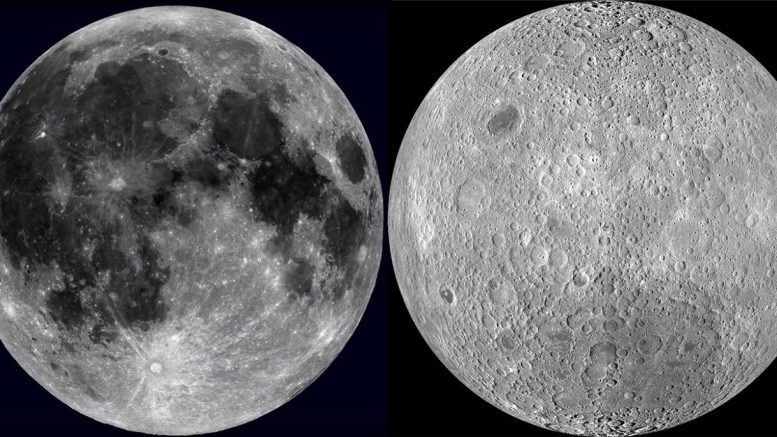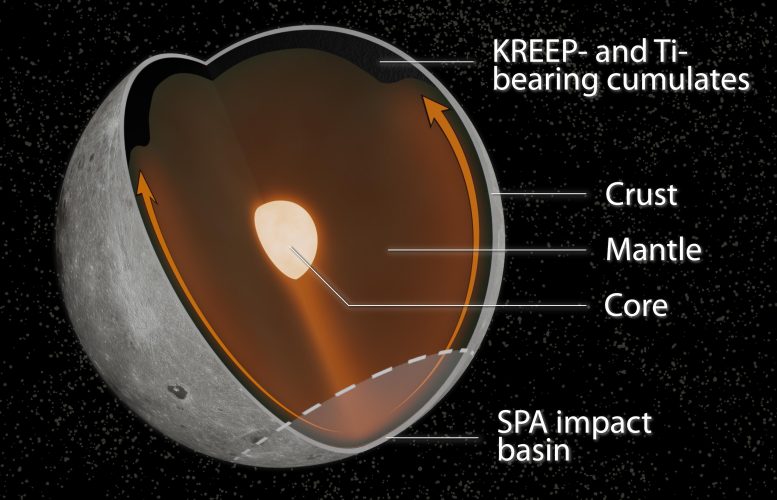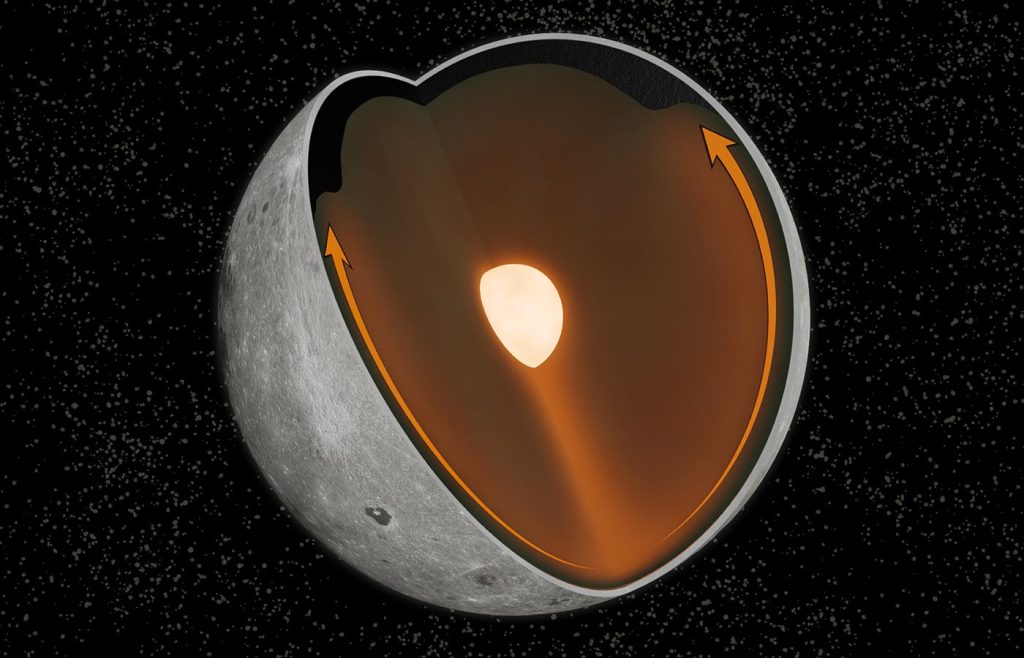Новое исследование показывает, что древнее столкновение с южным полюсом Луны изменило модели конвекции в лунной мантии, сосредоточив внимание на группе элементов, производящих тепло, на ближней стороне. Эти элементы сыграли роль в формировании огромной лунной подковы, видимой с Земли. Кредит: Мэтт Джонс
Новое исследование показывает, как воздействие Южного полюса Луны в бассейне Эйткен связано с резким контрастом в составе и внешнем виде между двумя сторонами Луны.
Лицо, которое Луна показывает Земле, сильно отличается от того, которое она скрывает на обратной стороне. На ближней стороне преобладают лунные персы — обширные темные остатки древних потоков лавы. С другой стороны, обратная сторона, заполненная кратерами, практически лишена обширных морских черт. Причина большой разницы между двумя сторонами — одна из самых непреходящих загадок Луны.
Теперь у исследователей есть новое объяснение двуликой Луны — объяснение, связанное с гигантским столкновением миллиарды лет назад вблизи южного полюса Луны.
Новое исследование, опубликованное в журнале Science Advances, показывает, что столкновение, сформировавшее на Луне гигантский бассейн Южный полюс-Эйткен (SPA), должно было создать массивный шлейф тепла, распространяющийся по недрам Луны. Этот шлейф должен был содержать определенные материалы — комбинацию редкоземельных элементов и элементов, выделяющих тепло, — а также ближайшую луну. Эта концентрация элементов могла способствовать вулканической активности, которая привела к созданию близлежащих вулканических равнин.

Обширные вулканические отложения преобладают на ближней стороне Луны (слева), в то время как на дальней стороне (справа) их гораздо меньше. Причиной большой разницы между двумя сторонами является тайна вечной луны. Предоставлено: Университет Брауна.
«Мы знаем, что большие воздействия, подобные тому, что сформировал SPA, создадут много тепла», — сказал Мэтт Джонс, доктор философии. Кандидат в Университете Брауна и ведущий автор исследования. Вопрос в том, как эта температура влияет на внутреннюю динамику Луны. Мы показываем, что при любых разумных условиях в то время, когда образуется SPA, он в конечном итоге концентрирует эти выделяющие тепло элементы на ближней стороне. Мы предполагаем, что это способствовало плавлению мантии, которое привело к потокам лавы, которые мы видим на поверхности. «
Исследование проводилось в сотрудничестве между Джонсом и его советником Александром Эвансом, доцентом Университета Брауна, а также исследователями из Университета Пердью, Лаборатории изучения Луны и планет в Аризоне, Стэнфордского университета и[{» attribute=»»>NASA’s Jet Propulsion Laboratory.

A new study reveals that an ancient collision on the Moon’s south pole changed patterns of convection in the lunar mantle, concentrating a suite of heat-producing elements on the nearside. Those elements played a role in creating the vast lunar mare visible from Earth. Credit: Matt Jones
The differences between the near and far sides of the Moon were first revealed in the 1960s by the Soviet Luna missions and the U.S. Apollo program. While the differences in volcanic deposits are plain to see, future missions would reveal differences in the geochemical composition as well. The nearside is home to a compositional anomaly known as the Procellarum KREEP terrane (PKT) — a concentration of potassium (K), rare earth elements (REE), phosphorus (P), along with heat-producing elements like thorium. KREEP seems to be concentrated in and around Oceanus Procellarum, the largest of the nearside volcanic plains, but is sparse elsewhere on the Moon.
Some scientists have suspected a connection between the PKT and the nearside lava flows, but the question of why that suite of elements was concentrated on the nearside remained. This new study provides an explanation that is connected to the South Pole–Aitken basin, the second largest known impact crater in the solar system.
For the study, the researchers conducted computer simulations of how heat generated by a giant impact would alter patterns of convection in the Moon’s interior, and how that might redistribute KREEP material in the lunar mantle. KREEP is thought to represent the last part of the mantle to solidify after the Moon’s formation. As such, it likely formed the outermost layer of mantle, just beneath the lunar crust. Models of the lunar interior suggest that it should have been more or less evenly distributed beneath the surface. But this new model shows that the uniform distribution would be disrupted by the heat plume from the SPA impact.
According to the model, the KREEP material would have ridden the wave of heat emanating from the SPA impact zone like a surfer. As the heat plume spread beneath the Moon’s crust, that material was eventually delivered en masse to the nearside. The team ran simulations for a number of different impact scenarios, from dead-on hit to a glancing blow. While each produced differing heat patterns and mobilized KREEP to varying degrees, all created KREEP concentrations on the nearside, consistent with the PKT anomaly.
The researchers say the work provides a credible explanation for one of the Moon’s most enduring mysteries.
“How the PKT formed is arguably the most significant open question in lunar science,” Jones said. “And the South Pole–Aitken impact is one of the most significant events in lunar history. This work brings those two things together, and I think our results are really exciting.”
Refernece: “A South Pole–Aitken impact origin of the lunar compositional asymmetry” by Matt J. Jones, Alexander J. Evans, Brandon C. Johnson, Matthew B. Weller, Jeffrey C. Andrews-Hanna, Sonia M. Tikoo and James T. Kean, 8 April 2022, Science Advances.
DOI: 10.1126/sciadv.abm8475

«Наркоман поп-культуры. Поклонник телевидения. Ниндзя алкоголика. Абсолютный фанат пива. Профессиональный знаток твиттера».






More Stories
Пентагон обеспокоен новыми шпионскими спутниками Илона Маска
Сверхновая, впервые замеченная в 1181 году, выпустила светящиеся нити.
Астрономы ждут, когда звезда-зомби снова взойдет